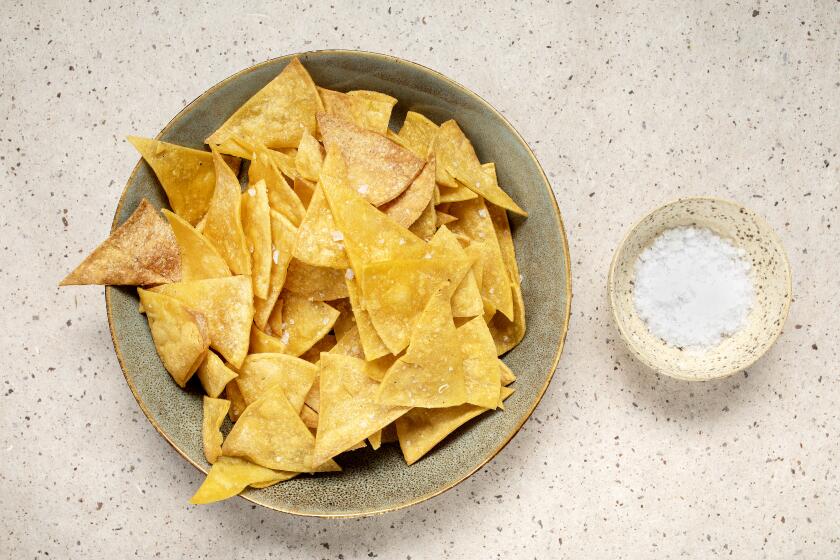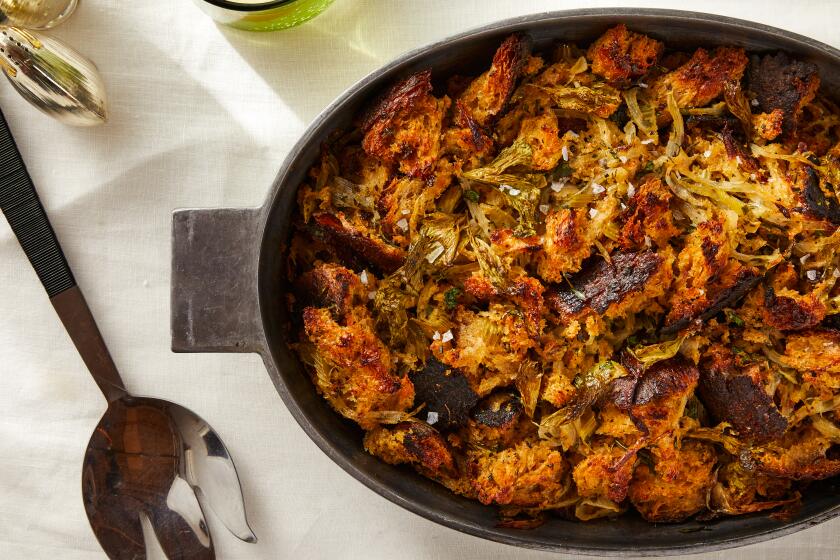Quick puff pastry

Every once in a while you stumble upon a culinary trick that changes your life in the kitchen. Learning how to peel ginger with a spoon. Finding out how to save a broken sauce. Figuring out how to convert a roasting pan into a stove-top smoker.
Recently I “discovered” the magic of quick puff pastry.
There is an elegant beauty to puff pastry. The way its paper-thin layers puff like magic, delicately crisp and golden. The way it shatters with each bite, shards of pastry flying about like bits of confetti. That deep buttery richness tucked inside lighter-than-air packaging.
I was taught in culinary school that classic puff pastry is one of those arts that separates the professional chef from the recreational cook. The method is laborious and unforgiving, even for professionals. Many bakeries prefer to buy their dough pre-made.
Classic puff pastry is made of a dough base, or detrempe, folded around a block of cold butter. The dough is repeatedly rolled out and folded around the butter until the dough and butter are stretched into paper-thin, almost translucent layers. Several folds can produce literally hundreds of layers. The challenge -- and art -- is keeping the butter at the right temperature. If the butter is too cold or is worked recklessly, it can crack and rupture the delicate layers of dough. Too warm and the softened butter will melt into the dough, dissolving the layers. The butter has to be just right -- kind of like Goldilocks, but in the kitchen.
I’d heard about quick puff pastry -- or “ruff puff,” as it’s sometimes called -- but never took it seriously. Puff pastry in a fraction of the time (and with a fraction of the stress) of the original? Frankly, it sounded too good to be true. But when I ran across yet another quick puff variation a few weeks ago, I decided to give the technique a try.
The results amazed me. Layered, flaky and deliciously rich, this was puff pastry almost like the original but in far less time. I was sold.
I love the simplicity of it. Quick puff pastry is very similar to a cut-in dough recipe. Think pie crust. Combine cold ingredients -- butter, flours, ice water -- and work the ingredients just to form a crumbly mass. But instead of forming the dough into a disc and refrigerating, as you would with pie dough, gently press the dough to form a rectangle, then fold it as if you were closing a book. Gently roll it out, then fold again. The whole mass is crumbly and unwieldy at first, but after the first couple of folds, it starts to come together. Cover and refrigerate the dough to chill and give it a chance to relax, then roll again and fold as if you were folding a letter. One more letter fold and you’re set. Puff pastry dough in about an hour.
I found that, as with pie dough, the easiest method for combining quick puff dough is in a food processor. Carole Bloom uses the method for her quick puff recipe in “The Essential Baker,” and I swear by it. A few whirls in a processor makes quick work of the dough, the pulses bringing everything together before the ingredients can even think about warming.
And you can’t beat the flavor. Like classic puff pastry, quick puff has a higher ratio of butter to flour. Another trick I learned from Bloom is adding a little lemon juice to the dough. You won’t taste the lemon juice itself, but baked into the pastry, the acid brings out the flavor of the other ingredients, intensifying the taste of the butter.
The dough is worked during the folds, giving it structure and strength. Rose Levy Beranbaum’s “Pie and Pastry Bible” includes a great recipe for quick puff using a blend of all-purpose and cake flours. The addition of lower-protein cake flour gives the dough structure without making it too “elastic” to roll. The dough will still work using only all-purpose flour, though the final pastry is slightly less delicate.
While you won’t have the clean, distinct layers formed using the classic method, the final dough still forms amazingly light -- and numerous -- crisp and flaky layers. Because the butter is cut in before folding, the final layers are more random -- like stacked puzzle pieces. You might notice the dough rising a little unevenly in places, though I found this to be minimal.
Like classic puff pastry, quick puff relies on cold ingredients for its characteristic puff. Here, the dough rises, or is “leavened,” by the steam created by the butter layers as the dough bakes, just as bread is leavened by yeast and cakes and quickbreads are chemically leavened with baking powder or soda. If the butter softens and is absorbed into the dough, you will lose the layers, and the pastry will bake up as flat as a cracker. Keep everything cold.
A great tip I learned from Beranbaum is to keep all the ingredients chilled, not just the butter. Chilling the flours too will help to keep the overall dough cold as it is worked together.
If you find that the dough is softening as you fold or roll it, or you’re working in a warm kitchen, wrap the dough and refrigerate it as often as needed to keep it chilled and firm.
As easy as it is to make, quick puff stores just as easily, so it’s ready when you need it. The dough will keep, refrigerated, for a few days and if tightly wrapped and frozen, can keep for months. Homemade puff pastry, ready at a moment’s notice.
Cover and freeze the butter and flours for 30 minutes to chill thoroughly.
In the bowl of a food processor, combine the all-purpose and cake flours, along with the salt. Pulse to combine.
Add half of the frozen butter pieces and pulse until the butter is reduced to the size of peas. Add the remaining half of the pieces, and continue to pulse until the size of peas.
Slowly add the water and lemon juice, and continue to pulse just until the dough begins to clump together.
Remove the dough to a floured board (using all-purpose flour), and form into a rectangle about 12 by 8 inches.
Fold the dough in half (the dough will be very crumbly at this point), then roll out again until the dough measures a 12-by-8-inch rectangle.
Fold the dough in half again, then cover and place in the freezer for 20 minutes.
Remove the dough and roll out into a rectangle. This time, fold the dough into thirds, as with a letter. Roll the dough out once more and fold again into thirds. Roll out and fold once more.
Cover and chill until ready to use.
Get our Cooking newsletter.
Your roundup of inspiring recipes and kitchen tricks.
You may occasionally receive promotional content from the Los Angeles Times.
















